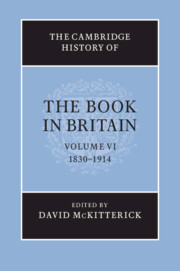Book contents
- Frontmatter
- Introduction
- 1 Changes in the look of the book
- 2 The illustration revolution
- 3 The serial revolution
- 4 Authorship
- 5 Copyright
- 6 Distribution
- 7 Reading
- 8 Mass markets: religion
- 9 Mass markets: education
- 10 Mass markets: children’s books
- 11 Mass markets: literature
- 12 Science, technology and mathematics
- 13 Publishing for leisure
- 14 Publishing for trades and professions
- 15 Organising knowledge in print
- 16 The information revolution
- 17 A place in the world
- 18 Second-hand and old books
- 19 A year of publishing: 1891
- 20 Following up The reading nation
- Bibliography
- Index
- Plate Sections
- References
3 - The serial revolution
Published online by Cambridge University Press: 28 March 2010
- Frontmatter
- Introduction
- 1 Changes in the look of the book
- 2 The illustration revolution
- 3 The serial revolution
- 4 Authorship
- 5 Copyright
- 6 Distribution
- 7 Reading
- 8 Mass markets: religion
- 9 Mass markets: education
- 10 Mass markets: children’s books
- 11 Mass markets: literature
- 12 Science, technology and mathematics
- 13 Publishing for leisure
- 14 Publishing for trades and professions
- 15 Organising knowledge in print
- 16 The information revolution
- 17 A place in the world
- 18 Second-hand and old books
- 19 A year of publishing: 1891
- 20 Following up The reading nation
- Bibliography
- Index
- Plate Sections
- References
Summary
This chapter concerns changing patterns of serial publication, a term we use to cover two related practices: the publishing of periodicals with miscellaneous contents, including both magazines and newspapers, and the issuing of unified texts at intervals in independent fascicles or parts. In practice, there is a good deal of overlap between these two modes, as indeed between serial publication in general and book publication itself. Parts are typically issued within paper covers bearing advertising material and are marketed alongside issues of magazines that look much the same. Periodicals commonly give over a significant proportion of their space to the serialisation of lengthy homogeneous works (the aspect we tend to focus on here), while the texts issued in parts can be remarkably heterogeneous ones like encyclopaedias or dictionaries. Both parts and periodicals are generally formatted so that either the purchaser or the vendor can have them bound up into volumes when the sequence is complete. This blurring of boundaries is also apparent in the instability of the terminology used to describe serial publication in the early decades of the Victorian period especially. Judging by the citations in the OED, though ‘number’, ‘part’ and ‘fascicle’, ‘miscellany’, ‘journal’, ‘magazine’ and ‘periodical’ have a rather longer history, the term ‘serial’ itself – whether as adjective or noun – only comes into common usage around the 1830s. The emergence of this new word helps to justify the use of the concept of ‘revolution’ to define the changes taking place in instalment publication during the nineteenth century.
Keywords
- Type
- Chapter
- Information
- The Cambridge History of the Book in Britain , pp. 144 - 171Publisher: Cambridge University PressPrint publication year: 2009
References
- 9
- Cited by



